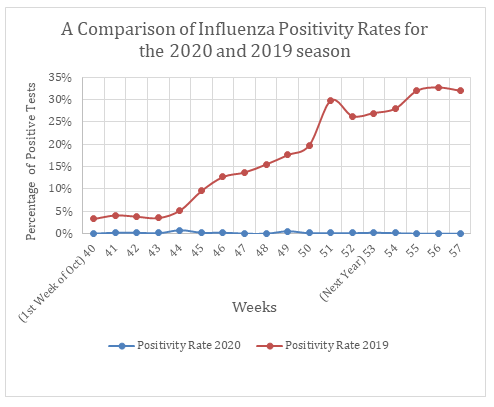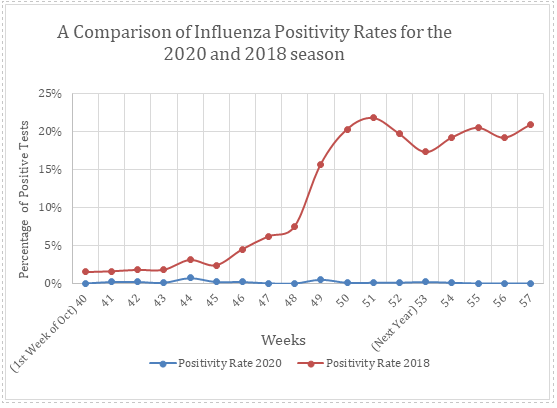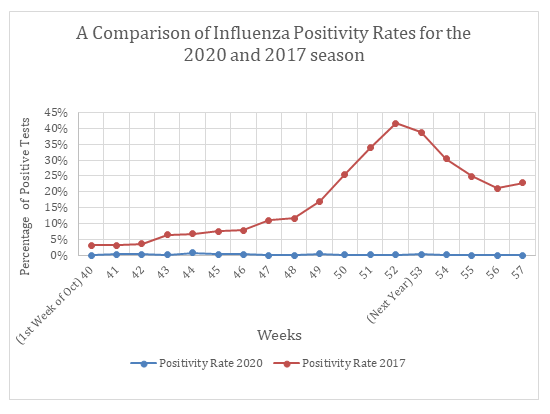Is the Twindemic Hitting California?
Article by Maya Shah.
Since the start of the Covid-19 pandemic, California health experts have worried about the twindemic — the overlap of increasing Covid-19 cases and a severe flu season. If the twindemic were to occur, the already stressed healthcare system would be further overwhelmed, especially in hard-hit states like California where ICU bed availability remained low throughout December 2020 and January 2021 (5). Additionally, because people may be less likely to go out and receive their yearly flu vaccination, the twindemic seemed imminent.
However, influenza case numbers indicate that the twindemic is not currently a problem in the golden state. The influenza positivity rate of the past four months has been much lower when compared to these months in previous years, as shown in the graphs below. The California Department of Public Health Influenza Surveillance Program, CISP, collects data related to influenza (case numbers, deaths, hospitalizations, etc) and releases it in weekly reports. Positivity rates are displayed in this study, instead of case numbers, because fewer influenza tests are being conducted this year. As a result, the percentage of positive tests is a better indication of how much influenza is spreading.
Generally, the flu season follows a pattern. During the month of October, positivity rates tend to be between 1.0 and 4.0 percent. In November and December, the flu rate begins to increase rapidly, with the following January having positivity rates between 20 and 40 percent.
This year, however, has been much different in comparison with prior years. In late 2020 and early 2021, the weekly flu positivity rate remained lower than 1% (the highest rate, 0.7%, occurred in Week 44, October 25 to October 31, 2020). The graphs below show the dramatic comparison of the 2020 flu season and the 3 years prior (1).



The considerably low flu rate this season indicates that the twindemic is not occurring. It also begs the question of why California has had a remarkably mild flu season compared to other years. One possible reason for the lower positivity rate is the social distancing measures that are currently in place and the closure of common transmission locations, such as schools and workplaces. One may question why flu rates are declining while Covid-19 numbers continue to be prevalent. Infectious disease specialists, like the CDC, speculate that Covid-19 is much more contagious than the flu. Additionally, Covid-19 has a longer incubation period. Influenza’s incubation period is 1 to 4 days (3), while Covid-19’s incubation period is 2 to 14 days (4). This means that people infected with Covid-19, but have not shown symptoms, will have a greater opportunity to spread the disease than people infected with influenza. The measures taken to reduce the spread of Covid-19 appear to work exceptionally well at mitigating influenza infections. Without these measures, the twindemic is possible.
1.https://www.cdph.ca.gov/Programs/CID/DCDC/Pages/Immunization/Flu-Reports.aspx
- https://www.nytimes.com/2020/08/16/health/coronavirus-flu-vaccine-twindemic.html
- https://www.immunize.org/catg.d/p4208.pdf
5.https://www.nytimes.com/2020/12/26/world/central-and-southern-california-icu-capacity.html


